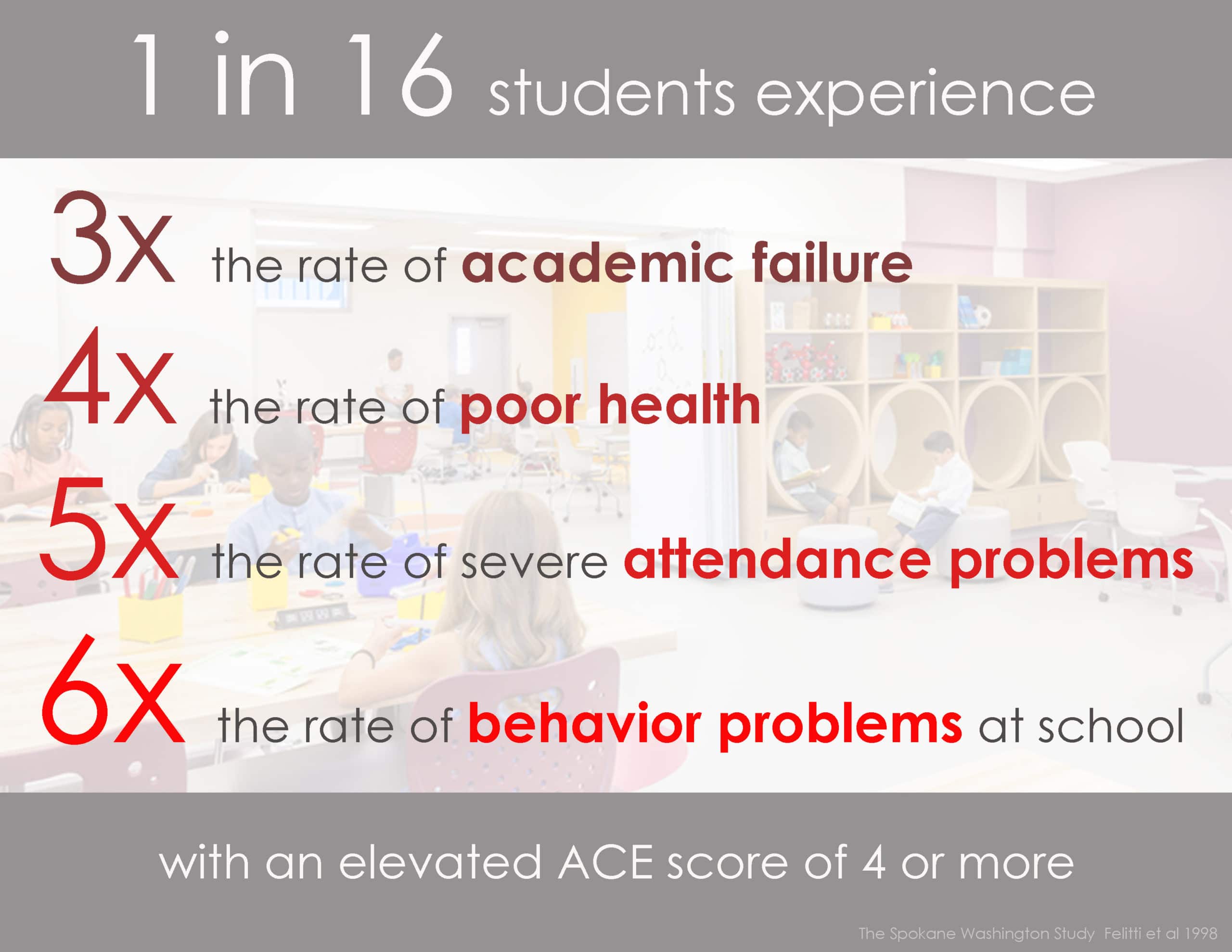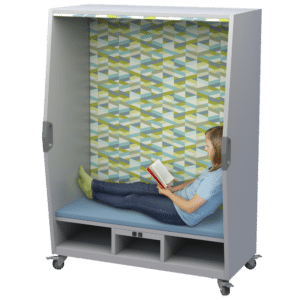An ACE (Adverse Childhood Experience) score (0-10) represents exposure to different categories of abuse, neglect and other traumatic events prior to the age of 18. Almost HALF the nation’s children have experienced at least one or more types of serious childhood trauma which can negatively affect their ability to engage in group learning. While collaboration and group learning are central to NextGen learning environments, it also presents a problem for kids with an ACE score. This is a challenge and opportunity to make students feel safe, connected and ready to learn with technology and innovative design solutions.

Foundational Research
The Adverse Childhood Experiences Study often referred to as the “ACE Study” was a collaboration between the CDC and Kaiser Permanente which included over 17,000 participants. The ACE study looked at possible impact of trauma on health and social functioning throughout the lifespan.
Adverse Childhood Experiences were found to be common and correlated with developing public health concerns such as domestic violence, alcoholism, depression, suicide attempts and chronic illnesses. This body of research recognized that the underlying cause of addictions are predominantly the body’s functional attempt to self sooth and cope with symptoms of trauma which is a large deviation from the disease model.
Similar findings were reflected in The Spokane Washington Study that identified elevated ACE Scores among children experiencing difficulties in the classroom. Students with an ACE score of 3 or more were found to be three times more likely to have academic failure, four times more to have poor health, and six times more likely to have behavioral problems.
1 in 16 children had an ACE Score of 4 or more.
In a typical class size, this would translate to 2 Students in a classroom that will have an 80% likelihood of academic challenges which will negatively impact their participation, ability to focus, recall and apply information. This will affect their attendance and overall health and their ability to manage their mood and behavior effetely in a group setting.
Development
The ACE study and the Spokane WA study have brought a better understanding to the overall prevalence of trauma. It’s equally important to understand the etiology of trauma in effort to intervene and address it.
Our brains develop individually before birth and into adulthood in the same sequence as our brains develop evolutionarily. The regions related to our biological survival, such as heart rate, develop first, our capacity for relational and emotional attachment next, then our more definitively human structures that allow for complex analytical tasks such as the Cortex, organize last.
The stress response system which mediates fight, flight, and freeze states, cannot differentiate between a threat that is triggered by a memory, something in the physical environment or an emotion. When this is activated, the cortex is temporarily inaccessible, significantly limiting thoughts, the ability to plan, or problem solve.
Developmental trauma causes the brain to function in a continual state of threat which shuts off the parts of the brain needed to participate in group learning and achieve academic success.
Research Informed Features and Applications of the Think Nook
Applying these principles to our work calls for a Paradigm shift.
Bruce Perry, a leader in neuroscience and children’s research, recommends helping children to regulate their nervous systems through patterned, repetitive, rhythmic activities that are somatosensory. Considering the sequence in which our brains develop, Bruce Perry suggests that we must be able to self-regulate before we can interrelate and build corrective relationships with others and exercise the capacity to cogitate which requires executive function. He emphasizes that healing occurs in the context of relationships.
AEC industry can rise to this challenge by incorporating technology and innovative design and collaborate with school districts to create supportive learning environments that benefit all students.
Self-Regulation

Consideration should first be given to promoting safety and self-regulation. Students feel safe when there is consistency and respect. Once safety is established for both Students and teachers, there is an opportunity for learning and creativity can take place.
The Think Nook has been used as a tool for Educators and their Students to develop mutually agreed upon guidelines for the classroom behavior and use of the Think Nook. Students participate in creating the culture and expectations for their classroom. Students are then able to enter the Think Nook on their own accord and have influence over their environment in effort to calm down, manage impulses, refocus and rejoin the class after the agreed upon delineation of time.
The side walls and high back of the Think Nook create privacy and minimize external stimulation. While the Student perceives increased safety and containment, the shallow walls of Think Nook allows them to be visible and supervised while enabling the Student to remain present for group learning. This reduces the need to remove Students from the classroom which can be interpreted as punitive and may further exacerbate trauma symptoms.
Collaboration
When Students are calm and alert, they are better able to interrelate and engage socially. The Think Nook is large enough to accommodate multiple student for engagement and group projects.
The back of the Think Nook can be used for ideation and collaboration to help students elicit growth focused mind sets which is highly motivating and correlated with academic achievement and resiliency. The Think Nook shifts away from prescriptive design that requires compliance, instead fostering opportunities for creativity, flexibility and empowerment to build confidence.
Executive function Skill Development
Utilization of the Think Nook provides a variety of opportunities for Students to practice and reinforce skill development and Executive Function (meaning working memory, cognitive flexibility and behavioral inhibition) which is essential for success in an academic setting. The design features support Students ability to concentrate and filter distractions to better recall and apply working information. The Think Nook allows for natural transitions between group work and independent learning. This can be further supported by allowing time for sensory breaks.
Educators play a quintessential role in early identification of trauma and interventions that support the self-regulation and safe relationships that are necessary for students to reach their full potential. This can have substantial value for underserved and marginalized youth, who are less likely to receive adequate mental health and health care.
Haskell’s innovative designs are not only the front line of makerspaces but are supporting Educators in addressing these goals.
References
Felitti, V.J., AndaR.F., Nordenberg, D., Williamson, D.F.,Spitz, A.M., Edwards, V., Koss, M.P., Marks, J.S. (May 1998). The Adverse Childhood Experiences (ACE) Study. American Journal of Preventative Medicine, Vol. 14 (4), Pages (245-258).
Blodgett, C., (2010) Spokane Childhood ACEs Study, Child and Family Research Unit, Spokane Washington. Retrieved from
http://ext100.wsu.edu/cafru/wp-content/uploads/sites/65/2015/02/Adverse-Childhood-Experience-and-Developmental-Risk-in-Elementary-Schoolchildren-Research-Briefx.pdf
SAMHSA 2014, an 2010 Trauma Informed Summit(April 15-17, 2012).
Perry, B. D. (2006-2012). The Child Trauma Academy. Neurosequential Model in Education. Retrieved from
http://images.pcmac.org/Uploads/ROELaSalle35/ROELaSalle35/Departments/DocumentsCategories/Documents/NME-_Child_Trauma.pdf
About the Author
Anna Iversen, MS, LMFT is a licensed therapist with 15 years experience in program development, creating and facilitating trainings, and treating complex clinical diagnoses in a variety of settings with diverse populations. She is passionate about staff development, leveraging humor and enthusiasm for research and innovative technologies to support health and wellness of medical professional as well as Educators. To learn more, contact Anna at info@annaiversen.com.
Back to Insights










